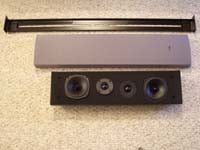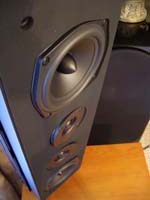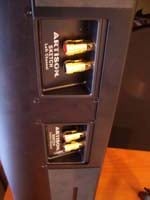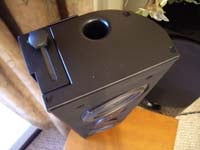Artison Sketch LCR Flat Panel Speakers Review
- Product Name: Sketch LCR
- Manufacturer: Artison
- Performance Rating:




- Value Rating:




- Review Date: January 25, 2006 19:00
- MSRP: $ 1100/pair (includes DualMono Center)
Type: Bass Reflex
Woofer:
Two 4.5" polypropylene midranges
Tweeter: 1" stage
tweeter
Tweeter: Two 1" Vifa soft dome
tweeters
Frequency Response: 80Hz – 20kHz (+/-
3dB)
Nominal Impedance: 6-ohms
Cabinet:
Black anodized aluminum
Sensitivity: 88dB @ 2.83 volts,
1m
Recommended Power:
Magnetic
Shielding: No
Dimensions: 24" H x 6" W x 3-1/2"
D
Dimensions (grilled): 6-3/8" W x 3-5/8" D (Height varies
based on the display model)
Weight: 26 lbs
Pros
- Flexible sizing to match any display
- Easy installation onto most flat panel displays
- High WAF
- Excellent high frequency detail
Cons
- Very expensive
- Recessed midrange
Artison Sketch LCR Build Quality
We got our first "up close and personal" look at Artison's products back at the 2004 CEDIA convention. Curt Chrisholm of Velodyne introduced us to these custom flat panel speakers (it was the Portrait model we first saw and heard.) The concept of a pair of flat panels that also sported a "DualMono" center channel intrigued us and we put it on our list to eventually contact them and arrange for a review. While it took us more than a year to do so, we were pleased to be able to take a closer look at Artison's new Sketch LCR loudspeakers. The Sketch line of speakers differs from the Portraits in that they replaced the Kevlar midranges with polypropylene, and substituted Vifa soft dome tweeters for the Super Audio tweeters. Both systems are designed by Cary Christie, previously of Infinity Systems, Inc. and Acoustic Research.
Artison manufactures their speakers specifically to address the needs of custom installers. As such, they are not available in most retail stores (we believe Tweeters now carries them) and are targeted primarily for a solution which helps the speakers to completely disappear into the plasma or LCD display. They accomplish this by custom sizing the speaker grill color and size to perfectly blend with a majority of today's flat panel products. By eliminating the need for a dedicated center channel box they further increase the aesthetics of a surround sound system.
We requested a pair of Artison Sketch speakers to go with an Optima PD50A plasma
display we were currently reviewing. It seemed best to pair the Artison's with a system that would
allow us to perform a complete assembly and test the full process of integrating these custom speakers
to a completely random display we had on hand.
Build Quality & Features
The Artison speakers arrived in three boxes. One box contained the loudspeakers themselves, another held the grills, and still another contained the required hardware for mounting them to the display. This is an efficient packaging system for the company as it allows them to mix and match as needed in order to deliver a system that perfectly complements a particular plasma or LCD product.In our case, the speakers came with light grey grills and hardware that was made to mount directly to the four rear mounting points of the plasma display. The hardware that came with the Artison speakers included almost every size of threaded bolt and washer used on currently shipping plasma and LCDs.
The Artison's glass beaded anodized aluminum cabinets were top notch. All of the hardware mounting pieces were powder coated. In taking a close look at the Sketch speakers I was given a glimpse at what the driver complement was and how Artison intended to use those drivers to accomplish its goals. The Dual Mono center channel units and midrange drivers are completely separated into their own chambers. Both are also ported to deliver some extra punch given their relatively small enclosure size. The 4.5" polypropylene drivers looked well built and the Vifa soft dome tweeters use neodymium magnets with heat sinking much like the ones they used in the past. The geometry of the cabinet and drivers is such that the left and right channel are directed outward from the screen a bit, while the top DualMono speakers are angled inward to originate sound from the center of the screen. The 4.5" drivers have phase plugs at the center and I found the overall construction of the drivers to be solid - from the stiff plastic basket (a nice step up from the typical Chinese stamped drivers) to the woven spider and rubber surrounds.Artison Sketch LCR Setup and Listening Tests
Each speaker is designated as right or left. This is important because you want the top, DualMono center channels firing inward and the lower left/right channels firing outward. Of course, if you flipped them you'd be doing some serious surgery to get them to attach, but that's beside the point. The speakers have 2 sets of gold-plated push post terminals for the center and main drives. Once installed, you connect a speaker wire (included) between the two center channel speaker terminals to create the DualMono center. With the included wire, it was a tight fit to also insert a 12-gauge speaker wire into the push post, but I managed. You may want to twist the ends together to create a single bundled end for insertion.
Speaking of those bars, the speakers came with felt-covered flat pieces of powder-coated metal which inserted into a horizontal mounting bracket which secured to the rear of the flat panel. The felt lining made sliding the speakers incredibly easy and smooth and also did a nice job of protecting all of the involved components in the process. By carrying the width of the center mounting bracket and adjusting the sliding positions of each speaker, display sizes from 40" - 63" can be accommodated (the minimum height of their shortest grille is 23.8".)
Listening Tests
This review is a bit unique in that Artison supplied us with a pair of Sketch speakers but not a complete 5.1 system. In order to test the center DualMono channel we needed to pop in some 5.1 content and, presumably, add a sub. Because this would obviously introduce a lot more elements into the mix, we decided to begin our listening sessions with two channel material and add in the DualMono speaker afterwards. When we did do 5.1 listening, we greatly de-emphasized the surround speaker volume and focused on the front three channels 舑 paying particular attention to the DualMono center.
Stereo Audio Testing
Richard Drexler My One and Only Love ( AppleJazz #AJCD0092 )
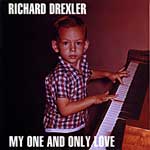 I queued up
the title track of this excellently recorded piano piece and settled back to hear the two-channel
capabilities of the Sketch system. I could clearly discern the soundstage and was listening for the
ability of these speakers to fill the room with music and allow sound to "escape" the confines of the
two boxes. The Sketch speakers are quite transparent. In fact, the raw piano keystrokes sounded as if
they were being played right in front of me. Reverb sounded natural in its smooth decay and the top end
attack of the upright bass was crisp. Brushes were used on the drums and their texture could almost be
felt. This system definitely succeeds in producing plenty of high frequency detail.
I queued up
the title track of this excellently recorded piano piece and settled back to hear the two-channel
capabilities of the Sketch system. I could clearly discern the soundstage and was listening for the
ability of these speakers to fill the room with music and allow sound to "escape" the confines of the
two boxes. The Sketch speakers are quite transparent. In fact, the raw piano keystrokes sounded as if
they were being played right in front of me. Reverb sounded natural in its smooth decay and the top end
attack of the upright bass was crisp. Brushes were used on the drums and their texture could almost be
felt. This system definitely succeeds in producing plenty of high frequency detail.
Track 3 "Early in the Morning" served up more of the same great soundstage, this time narrower due to the particular mix 舑 but clear nonetheless. Acoustics bass entered more distinctly after about 2 minutes into the song and the Artison's lent themselves very well to reproducing the sound of that instrument within the mix. The Sketch speakers also blended well with the RBH Sound SI-1010/P subwoofer utilized in the listening room. With this system a decent subwoofer is going to be a necessary item for anyone desiring to get full bodied sound from these speakers.
Sting Ten Summoner's Tales CD
 For something a bit more
contemporary I popped in Sting's Ten Summoner's Tales album and pressed
'Play'. Right off the bat
I noticed that the upper frequency response was ultra clear and crisp, but I wanted a bit more out of
the midrange -
it just wasn't present with enough gusto to liberate this track to its potential.
Artison stated that this is a result of crossover voicing as opposed to driver size. They indicated
that you may have to introduce and raise the center channel level during set up to balance to a
particular preference. As I was doing 2-channel listening tests, I suppose the suggestion here is to
introduce Pro Logic II Music modes and adjust to taste. This track was also much more compressed
(indeed, so is the album) which carries its own set of challenges. "Fields of Gold" had more breathing
room in the mix and sounded very full on the Sketch speakers. The short guitar solo about two minutes
into the song was distinct and crisply detailed. Background music elements could easily be
differentiated within the mix and I never felt that the loudspeakers were compressing the tracks for
lack of dynamics. "Seven Days" is the final track I evaluated and I selected it for its ultra-wide
reverberant mix. This came through completely whereas other speakers I have heard collapsed the
soundstage for inability to deliver the necessary decay time and detail. This is particularly important
as you cannot exactly toe-in these speakers (or any flat panel speakers we know of) to compensate for
poor off-axis upper frequency response. With the Artisons, you don't need to.
For something a bit more
contemporary I popped in Sting's Ten Summoner's Tales album and pressed
'Play'. Right off the bat
I noticed that the upper frequency response was ultra clear and crisp, but I wanted a bit more out of
the midrange -
it just wasn't present with enough gusto to liberate this track to its potential.
Artison stated that this is a result of crossover voicing as opposed to driver size. They indicated
that you may have to introduce and raise the center channel level during set up to balance to a
particular preference. As I was doing 2-channel listening tests, I suppose the suggestion here is to
introduce Pro Logic II Music modes and adjust to taste. This track was also much more compressed
(indeed, so is the album) which carries its own set of challenges. "Fields of Gold" had more breathing
room in the mix and sounded very full on the Sketch speakers. The short guitar solo about two minutes
into the song was distinct and crisply detailed. Background music elements could easily be
differentiated within the mix and I never felt that the loudspeakers were compressing the tracks for
lack of dynamics. "Seven Days" is the final track I evaluated and I selected it for its ultra-wide
reverberant mix. This came through completely whereas other speakers I have heard collapsed the
soundstage for inability to deliver the necessary decay time and detail. This is particularly important
as you cannot exactly toe-in these speakers (or any flat panel speakers we know of) to compensate for
poor off-axis upper frequency response. With the Artisons, you don't need to.
Multi-Channel Audio Testing to Evaluate the DualMono Center Channel
In testing the Artison Sketch speakers' DualMono center channel I lined up several multi-channel music discs and recalibrated the entire system for levels and crossover, but then backed off the surrounds by about 6dB. In this way I was able to concentrate on the DualMono center channel performance when utilized with multi-channel audio tracks
Eagles Hell Freezes Over (DTS)
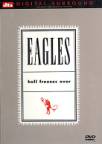 The first song I
played off this DTS album was "I Can't Tell You Why". This disc is more of a live concert mix, having
most of the music content up front and making lots of use of the center channel. Vocals were smooth,
but laid back and I found that I preferred raising the center channel level about 1-2 dB to get a
better presence. The Sketch speakers did not seem to have a problem imaging, but it was much narrower
on this mix than I have heard on other box speakers. "New York Minute" introduced some distinct piano
which did seem to transcend the boundaries of the loudspeakers and extend towards to the side walls.
The top end of the bass was crisp and reverb held a nice long decay.
The first song I
played off this DTS album was "I Can't Tell You Why". This disc is more of a live concert mix, having
most of the music content up front and making lots of use of the center channel. Vocals were smooth,
but laid back and I found that I preferred raising the center channel level about 1-2 dB to get a
better presence. The Sketch speakers did not seem to have a problem imaging, but it was much narrower
on this mix than I have heard on other box speakers. "New York Minute" introduced some distinct piano
which did seem to transcend the boundaries of the loudspeakers and extend towards to the side walls.
The top end of the bass was crisp and reverb held a nice long decay.
Toy Matinee (DTS)
 "Turn It Up Salvadore" from the
Toy Matinee DTS disc brought guitars to the forefront as well as a snare with a nice, tight snap. Both
sounded very good and imaged well with the DualMono center channel. The soundstage on this disc was
about as wide as the display and center channel content was clearly and cleanly anchored in the center
of the screen. Vocals on this track and the next, "Things She Said", were a tad lacking in midrange
detail. It was almost as if the 4.5" midrange drivers were outclassed by the Vifa tweeters. Again, I
felt as if this was a necessary design limitation and it still left a pleasing overall
experience.
"Turn It Up Salvadore" from the
Toy Matinee DTS disc brought guitars to the forefront as well as a snare with a nice, tight snap. Both
sounded very good and imaged well with the DualMono center channel. The soundstage on this disc was
about as wide as the display and center channel content was clearly and cleanly anchored in the center
of the screen. Vocals on this track and the next, "Things She Said", were a tad lacking in midrange
detail. It was almost as if the 4.5" midrange drivers were outclassed by the Vifa tweeters. Again, I
felt as if this was a necessary design limitation and it still left a pleasing overall
experience.
Artison Sketch LCR Conclusion
The Artison Sketch speakers aren't inexpensive, until you consider the fact that they are really three speakers, not two. As Artison sells these speakers only to custom installers and not through retail stores - the value is even more apparent. Their sound is detailed and they can put forth a wide soundstage with good source material. While the midrange could sound a bit recessed at times, the Vifa tweeters had an incredible amount of detail and air. The truly amazing aspect of these speakers is their ability to be ordered to fit almost any size flat panel display. For an installer looking to create truly seamless look for their clients, there's simply no beating these speakers. Their intuitive design and ease of installation are simply icing on the cake.
The Score Card
The scoring below is based on each piece of equipment doing the duty it is designed for. The numbers are weighed heavily with respect to the individual cost of each unit, thus giving a rating roughly equal to:
Performance × Price Factor/Value = Rating
Audioholics.com note: The ratings indicated below are based on subjective listening and objective testing of the product in question. The rating scale is based on performance/value ratio. If you notice better performing products in future reviews that have lower numbers in certain areas, be aware that the value factor is most likely the culprit. Other Audioholics reviewers may rate products solely based on performance, and each reviewer has his/her own system for ratings.
Audioholics Rating Scale




 — Excellent
— Excellent



 — Very Good
— Very Good


 — Good
— Good

 — Fair
— Fair
 — Poor
— Poor
| Metric | Rating |
|---|---|
| Build Quality | |
| Appearance | |
| Treble Extension | |
| Treble Smoothness | |
| Midrange Accuracy | |
| Imaging | |
| Soundstage | |
| Dynamic Range | |
| Performance | |
| Value |


